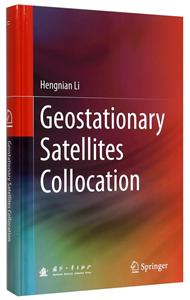-
>
湖南省志(1978-2002)?铁路志
-
>
公路车宝典(ZINN的公路车维修与保养秘籍)
-
>
晶体管电路设计(下)
-
>
基于个性化设计策略的智能交通系统关键技术
-
>
德国克虏伯与晚清火:贸易与仿制模式下的技术转移
-
>
花样百出:贵州少数民族图案填色
-
>
识木:全球220种木材图鉴
Geostationary Satellites Collocation-地球静止卫星轨道与共位控制技术 版权信息
- ISBN:9787118094923
- 条形码:9787118094923 ; 978-7-118-09492-3
- 装帧:一般胶版纸
- 册数:暂无
- 重量:暂无
- 所属分类:>
Geostationary Satellites Collocation-地球静止卫星轨道与共位控制技术 内容简介
《地球静止卫星轨道与共位控制技术(英文版)》重点叙述了地球静止卫星轨道运动及摄动理论;系统介绍了静止卫星轨道控制理论与方法,以及静止卫星多星共位控制理论与算法等技术;突出阐述了地球静止卫星多星共位控制原理及应用。 《地球静止卫星轨道与共位控制技术(英文版)》注重理论与实践的结合,力求透彻介绍地球静止卫星轨道运动、控制原理。
Geostationary Satellites Collocation-地球静止卫星轨道与共位控制技术 目录
1.1 General
1.2 The Geostationary Orbit in Math
1.3 The Status of Geostationary Satellites
1.4 The Framework of the Book
References
2 Orbit Motion Foundations
2.1 Introduction
2.2 The Motion of the Earth
2.2.1 A Solar Day
2.2.2 A Sidereal Day
2.2.3 Equinox Direction
2.2.4 Primary Longitude
2.2.5 Local Solar Time
2.2.6 Polar Motion
2.2.7 Precession Motion
2.2.8 Nutation Motion
2.3 Time System
2.3.1 Seconds in a Day
2.3.2 Sidereal Time and Universal Time...
2.3.3 Julian Days and Modified Julian Days
2.3.4 Greenwich Sidereal Time
2.3.5 International Atomic Time
2.3.6 Coordinated Universal Time
2.3.7 Local Time
2.3.8 Ephemeris Time
2.3.9 GPS Time
2.3.10 Time System Summaries
2.4 Reference System
2.4.1 Background and General Definitions
2.4.2 J2000.0 Earth-Centered Inertial System
2.4.3 The Mean Equator and Equinox
2.4.4 The True Equator and Equinox
2.4.5 The Greenwich Meridian-Fixed System
2.4.6 International Terrestrial Reference System
2.4.7 Global Geodetic System
2.4.8 Local Tangential Coordinate System
2.4.9 Orbit RTN Coordinate System
2.4.10 Satellite-Fixed Orbit Coordinate System
2.4.11 Satellite-Fixed East/South/Down Coordinate Frame
2.4.12 Satellite Body Coordinate System
2.5 The Kepler Orbit
2.5.1 Kepler Orbit Elements
2.5.2 The Kepler Orbit with Motion States
2.5.3 The Kepler Orbit with Reference System
2.5.4 The Station Keeping Element
References
3 The Motion of Geostationary Satellite
3.1 Introduction
3.2 The Geostationary Orbit in Inertial Space
3.3 The Geostationary Orbit Relative to the Earth
3.3.1 Linearization of Geocentric Distance
3.3.2 Linearization of the True Anomaly
3.3.3 Linearization of Right Ascension and Longitude
3.3.4 Linearization of Relative Declination
3.4 The Truth of "8"-Shape Subsatellite
3.5 The Relative Motion with Nominal Longitude
3.5.1 The Orbit Motion Projected on the Equator Plane
3.5.2 The Orbit Motion Projected on the Meridian Plane
3.5.3 Relative Motion Projected on the Local Horizontal Plane
4 Geostatlonary Orbit Perturbation
4.1 Introduction
4.2 Natural Evolution Motion Scenery
4.3 Lagrange Equation for Station Keeping Elements
4.3.1 Lagrange Equation for the Drift Vector
4.3.2 Lagrange Equation for the Eccentricity Vector
4.3.3 Lagrange Equation for the Inclination Vector
4.4 The Earth's Non-spherical Perturbation
4.4.1 The Earth's Non-spherical Potential Function
4.4.2 Real Geostationary Orbit
4.4.3 Semi-major Axis Evolution
4.4.4 Longitude Drift Evolution
4.4.5 Mean Longitude Evolution
4.4.6 Inclination Vector Evolution
4.4.7 Eccentricity Vector Evolution
4.5 The Solar and Lunar Perturbation
4.5.1 The Lunar and Solar Potential Function
4.5.2 Semi-major Axis Evolution
4.5.3 Longitude Evolution
4.5.4 Eccentricity Evolution
4.5.5 Inclination Evolution
4.5.6 Solar-Lunar Ephemeris
4.6 The Solar Radiation Perturbation
4.6.1 Solar Radiation Pressure Potential Function.
4.6.2 Longitude Drift Evolution
4.6.3 Eccentricity Evolution
4.6.4 Inclination Evolution
4.6.5 Eclipses of the Solar by the Earth and Moon
4.7 Perturbation Summaries
References
5 Harmonic Analysis Geostationary Orbit
5.1 Introduction
5.2 Harmonic Analysis
5.3 Basic Functions and Periodic Expansion
5.4 Determining the Coefficients with SVD Method
5.5 Longitude and Drift Harmonics
5.6 Eccentricity Vector Harmonics
5.7 Inclination Vector Harmonics
References
6 Correction Geostationary Orbit
6.1 Introduction
6.2 Relative Motion Equation
6.2.1 Radial Equation
6.2.2 Tangential Equation
6.2.3 Normal Equation
6.3 Orbit Correction Equation
6.4 Radial Impulse
6.5 Tangential Impulse
6.6 Normal Impulse
6.7 Continuous Thrust
6.8 Onboard Thrust Configuration
7 Maintaining Geostationary Orbit
7.1 Introduction
7.2 North/South Station Keeping Strategy
7.2.1 General Background
7.2.2 Inclination Dead Band Allocation
7.2.3 Inclination Maneuver Strategy
7.2.4 Maneuver Calculation
7.2.5 Maneuver Planning
7.2.6 Case Study and Simulation
7.3 East/West Station Keeping Strategy
7.3.1 General Background
7.3.2 Longitude Dead Band Allocation
7.3.3 Longitude Maneuver Strategy
7.3.4 Eccentricity Maneuver Strategy
7.3.5 Maneuver Calculation
7.3.6 Single-Pulse Maneuver Planning
7.3.7 Bi-Pulse Maneuver Planning
7.3.8 Tri-Pulse Maneuver Planning
References
8 Collocation Prototypes and Strategies
8.1 Introduction
8.2 Reference and Notation
8.3 Collocation Relative Motion
8.4 Collocation Principles
8.5 Complete Longitude Separation
8.6 Eccentricity Separation
8.6.1 Absolute Eccentricity Offsetting Strategy
8.6.2 Relative Eccentricity Offsetting Strategy
8.6.3 Evaluation of Eccentricity Separation Strategy
8.6.4 Solar Leading Eccentricity Control Strategy..
8.7 Combined Eccentricity and Inclination Separation
8.7.1 The Mathematical Prototype of E/I Strategy..
8.7.2 Inclination Distribution Strategy
8.7.3 Inclination Maintenance Strategy
8.8 A Bi-Satellite E/I Combined Separation Method
8.9 A Coordinated E/I Combined Separation Method
8.10 A Tri-Satellite Hybrid e-i Separation Method
8.11 Safety Analysis and Collision Warning
References
Geostationary Satellites Collocation-地球静止卫星轨道与共位控制技术 节选
《地球静止卫星轨道与共位控制技术(英文版)》: By making use of the amount and phase offset of the mean eccentricity, a separation distance in the radial direction will be achieved between collocated satellites, which is a very appropriate method for non—cooperative collocation control for two or multiple satellites.According to the collocation plan, two satellites acquire the eccentricity vector and the choice of an appropriate control time.By East/West maneuver, the eccentricity vector offset can be maintained, satisfying the orbit constraint condition defined by the collocation plan.But, the eccentriciLy constraint condition may be damaged by North—South coupling control.Therefore, generally speaking, after North—South maneuver, the eccentricity vector will be reacquired and the eccenfflcity constraint condition will be reconstructed through East/West maneuver.Therefore, in terms of safety, necessary orbit information should be exchangedperiodically between two sides, including orbit mean eccentricity magnitude and direction.Because both East/West and North—South maneuvers are carried out independemly, the orbit elements and control plan exchanging are not necessary. ……
- >
朝闻道
朝闻道
¥10.2¥23.8 - >
人文阅读与收藏·良友文学丛书:一天的工作
人文阅读与收藏·良友文学丛书:一天的工作
¥17.9¥45.8 - >
伯纳黛特,你要去哪(2021新版)
伯纳黛特,你要去哪(2021新版)
¥15.9¥49.8 - >
推拿
推拿
¥12.2¥32.0 - >
姑妈的宝刀
姑妈的宝刀
¥9.6¥30.0 - >
有舍有得是人生
有舍有得是人生
¥17.4¥45.0 - >
二体千字文
二体千字文
¥14.0¥40.0 - >
小考拉的故事-套装共3册
小考拉的故事-套装共3册
¥36.7¥68.0
-
工业机器人操作与编程
¥19.6¥58 -
扫描电镜和能谱仪的原理与实用分析技术(第2版)
¥137.2¥188 -
北京通信电信博物馆
¥21.8¥46 -
等离子体蚀刻及其在大规模集成电路制造中的应用(第2版)
¥111.8¥149 -
现代微波技术基础
¥14.5¥21


















